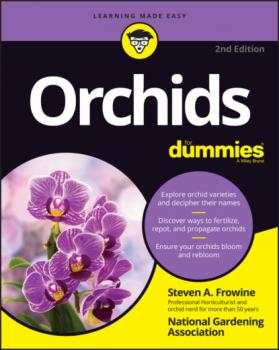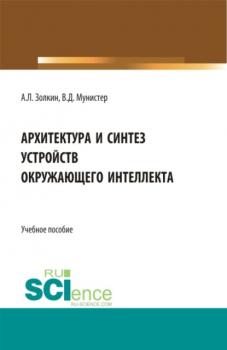Техническая литература
Различные книги в жанре Техническая литератураOrchids For Dummies
Become a plant parent to some of the most stunning flowering plants you’ve ever seen Orchids display more beautiful and exotic flowers than you’ll find on other flowering plants, but they do require some love and care to grow well. With help from Orchids For Dummies, anyone can be successful in growing and flowering these gorgeous and fragrant plants in their garden or home! This step-by-step guide shows you how to select orchids that will thrive in your own unique environment and how to water, fertilize, repot, and propagate them on your own. You’ll learn to decipher complicated orchid names (“phalaenopsis,” anyone?) and create spectacular displays. You’ll also discover: New information about updated plant and orchid classification systems so you can know what to buy at your local garden center or store Expanded info on moth orchids, one of the most popular varieties of the plant sold in the world today Updated instructions on which pesticides, fertilizers, and potting materials you should be using Perfect for amateur gardeners, orchid-lovers, and anyone interested in growing these exquisite flowers on their own, Orchids For Dummies will turn your thumb green in no time at all!
Fish and Fisheries in Estuaries
Fish and Fisheries in Estuaries: A Global Perspective brings together the current state of knowledge of estuarine fish in one inclusive work. Featuring contributions by more than fifty internationally-recognized researchers and estuarine ichthyological specialists, this landmark resource covers fish assemblages and functional groups, recruitment and production in estuaries, feeding ecology and trophic dynamics, fisheries and the conservation of estuarine fish, and much more. Thirteen in-depth chapters and two method appendices examine major aspects of fish and fisheries in estuaries throughout the world. The text describes the biology of estuarine fish and their connections with estuarine and adjacent marine and freshwater ecosystems, as well as examining the ways human industrialization and global events such as climate change are impacting both native and non-native species. Topics include habitat diversity, fish foraging behavior, ecological engineering tools and models, hazards and risks to estuarine fish and fisheries, and estuarine environmental health. Offering detailed information on the biology and ecology of estuarine fish and fisheries, this authoritative reference: Explores current approaches and future research directions aimed at achieving a balance between exploitation and conservation of estuarine fishes Discusses environmental quality objectives and sustainable management of estuary fisheries Addresses the impacts of increased human use of resources such as food, space, and water to estuarine fish and fisheries Features numerous international case studies of management of fisheries, threatened species, estuarine rehabilitation, reproduction and ontogeny, and others Covers study and sampling methods, field equipment, and data processing, analysis, and interpretation Fish and Fisheries in Estuaries: A Global Perspective is an indispensable tool and reference point for fish biologists, fisheries scientists, ecologists and environmental scientists, aquatic ecologists, conservation biologists, estuarine managers and advanced students and instructors in fish biology and fisheries programs.
Food Chemistry
FOOD CHEMISTRY A manual designed for Food Chemistry Laboratory courses that meet Institute of Food Technologists undergraduate education standards for degrees in Food Science In the newly revised second edition of Food Chemistry: A Laboratory Manual , two professors with a combined 50 years of experience teaching food chemistry and dairy chemistry laboratory courses deliver an in-depth exploration of the fundamental chemical principles that govern the relationships between the composition of foods and food ingredients and their functional, nutritional, and sensory properties. Readers will discover practical laboratory exercises, methods, and techniques that are commonly employed in food chemistry research and food product development. Every chapter offers introductory summaries of key methodological concepts and interpretations of the results obtained from food experiments. The book provides a supplementary online Instructor’s Guide useful for adopting professors that includes a Solutions Manual and Preparation Manual for laboratory sessions. The latest edition presents additional experiments, updated background material and references, expanded end-of-chapter problem sets, expanded use of chemical structures, and: A thorough emphasis on practical food chemistry problems encountered in food processing, storage, transportation, and preparation Comprehensive explorations of complex interactions between food components beyond simply measuring concentrations Additional experiments, references, and chemical structures Numerous laboratory exercises sufficient for a one-semester course Perfect for students of food science and technology, Food Chemistry: A Laboratory Manual will also earn a place in the libraries of food chemists, food product developers, analytical chemists, lab technicians, food safety and processing professionals, and food engineers.
Химия нефти и газа. (Бакалавриат, Магистратура). Учебное пособие.
Рассмотрено современное состояние развития нефтегазоперерабатывающей промышленности России и мира. Описаны физические и химические свойства углеводородных и неуглеводородных соединений, входящих в состав природных газов. Дана классификация нефтей и рассмотрены вопросы происхождения нефти. Описаны основные физико-химические свойства нефти и методы их определения. Рассмотрены элементный и химический состав нефти и химические свойства групповых составляющих. Изложены вопросы образования и разделения водонефтяных эмульсий. Приведены примеры современных схем переработки нефти и производства нефтехимической продукции. Соответствует ФГОС ВО последнего поколения. Для студентов бакалавриата и магистратуры, обучающихся по направлению «Нефтегазовое дело».
Основы общей и биоорганической химии. (Бакалавриат, Специалитет). Учебное пособие.
Евгений Владиславович Дмитриев
Изложены сведения о фундаментальных закономерностях химических явлений (общая химия) и характеристики основных классов неорганических и органических веществ по схеме: элементарный состав, химическая природа (принадлежность к определенному классу), классификация и номенклатура, физические и химические свойства, биологические функции. Особое внимание уделено характеристике биогенных веществ, что позволяет рассматривать учебное пособие как вводный курс для изучения биохимии и других общепрофессиональных дисциплин. Включен словарь (глоссарий) терминов и определений, наиболее часто встречающихся в химии. Соответствует ФГОС ВО последнего поколения. Для студентов институтов физической культуры. Может представлять интерес также для студентов других специальностей высших и средних профессиональных учебных заведений и для всех, кто интересуется химией и биохимией.
Приготовление, оформление и подготовка к реализации хлебобулочных, мучных кондитерских изделий разнообразного ассортимента. (СПО). Учебник.
Приведены характеристики организации, технического оснащения работ и санитарно-гигиенические требования к ведению технологического процесса приготовления, оформления, хранения, подготовки к реализации хлебобулочных и мучных кондитерских изделий. Рассмотрены классификация, ассортимент, товароведческая характеристика используемого сырья и готовых промышленных смесей. Даны правила взаимозаменяемости сырья, оценки качества сырья и безопасности продукции. Изложены современные технологии приготовления отделочных полуфабрикатов и отделки изделий, способы оформления и технологии приготовления полуфабрикатов для мучных кондитерских изделий. Соответствует ФГОС СПО последнего поколения. Для студентов среднего профессионального образования, обучающихся по специальности «Повар, кондитер».
Технология приготовления полуфабрикатов для сложной кулинарной продукции и еПриложение. (СПО). Учебник.
Подробно рассказывается о технологии приготовления полуфабрикатов, рассматриваются способы кулинарной обработки и их классификация, изучаются используемые в процессе приправы. Раскрываются процессы производства полуфабрикатов из овощей, рыбы, мяса, птицы и др. Соответствует ФГОС СПО последнего поколения. Для студентов среднего профессионального образования, обучающихся по специальности «Технология продукции общественного питания».
Архитектура и синтез устройств окружающего интеллекта. (Бакалавриат, Магистратура). Учебное пособие.
В учебном пособии излагаются основные принципы и методы синтеза управляющих микропроцессорных систем и конечного оборудования в рамках парадигмы окружающего интеллекта. Рассматриваются способы организации микроархитектуры контроллеров и координаторов Internet of Things. Учебное пособие в равной степени может представлять интерес как для образовательных целей в высшей школе для изучения таких дисциплин как «Информатика», «Системный анализ» «Вычислительная техника и языки программирования», «Архитектура ЭВМ», "Интернет вещей", «Информационные системы», «Микропроцессорные системы», «Информационно-телекоммуникационные системы», «Основы алгоритмизации, мировые информационные ресурсы и медико-биологическая статистика», так и для практического применения на предприятиях и в организациях.
Задачи и упражнения по общей химии. (Бакалавриат, Специалитет). Учебное пособие.
Содержит задачи и упражнения по различным разделам общей химии, в том числе: простейшие стехиометрические расчеты, основные классы неорганических соединений, строение атома, химическая связь, периодическая система элементов, свойства элементов и их соединений. Дополнено двумя новыми разделами: «Эквиваленты окислителей и восстановителей» и «Магнитные и оптические свойства комплексных соединений. Пространственная структура комплексных соединений». Особое внимание уделено строгому применению Международной системы физических единиц (СИ). Для студентов и преподавателей вузов.
Ручная дуговая сварка (наплавка, резка). (СПО). Учебник.
Содержит сведения по материалам, свариваемым ручной дуговой сваркой покрытым электродом, конструкции покрытых электродов, маркам электродов, принципам выбора марки электрода для сварки конкретного металла. Приведены данные по технике выполнения швов в различных пространственных положениях плавящимся покрытым электродом, по технологии выполнения наплавки и резки. Рассмотрены особенности дуговой сварки и наплавки неплавящимся электродом в защитном газе, приведены марки неплавящихся электродов, присадочной проволоки и защитных газов, вопросы технологии дуговой сварки и наплавки неплавящимся электродом в защитном газе различных металлов и сплавов. Соответствует ФГОС СПО последнего поколения. Для студентов, обучающихся по специальности «Сварщик (ручной и частично механизированной сварки (наплавки))».









